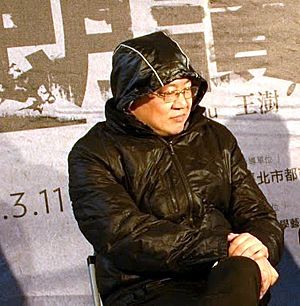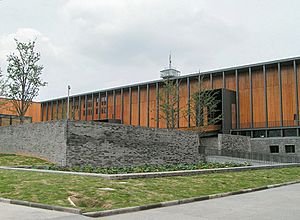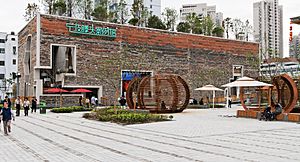Wang Shu facts for kids
Quick facts for kids
Wang Shu
|
|
|---|---|
 |
|
| Born | 4 November 1963 Ürümqi, Xinjiang, China
|
| Nationality | Chinese |
| Other names | 王澍 |
| Alma mater | Nanjing Institute of Technology, now known as Southeast University, and Tongji University |
| Occupation | Architect |
| Awards | Pritzker Prize |
| Buildings | Ningbo Museum |
Wang Shu (Chinese: 王澍) is a famous Chinese architect. He was born on November 4, 1963. He lives in Hangzhou, China. Wang Shu is the head of the School of Architecture at the China Academy of Art.
He started his own architecture company, Amateur Architecture Studio. He did this with his wife and partner, Lu Wenyu. In 2012, Wang Shu made history. He became the first Chinese person to win the Pritzker Prize. This is the highest award an architect can receive worldwide.
Contents
Early Life and Education
Wang Shu was born in Ürümqi, a city in western China. From a young age, he loved to draw and paint. He learned on his own, without formal art classes.
Even during a difficult time in China (1966–1976), his mother helped him. She gave him access to books. He read many different kinds of stories.
Wang Shu's parents suggested he study architecture. This was a good mix of his love for art and engineering. He studied at Southeast University in Nanjing. He earned his bachelor's degree in 1985. Then, he got his master's degree in 1988.
After college, Wang Shu moved to Hangzhou. He loved the city's beautiful nature and old art traditions. In 1990, he finished his first building. It was a youth center in Haining, near Hangzhou.
Wang Shu did not take on new projects between 1990 and 1998. During this time, his wife, Lu Wenyu, supported their family. He used this time to continue his studies. He earned his PhD in 2000 from Tongji University in Shanghai.
His Career as an Architect
In 1997, Wang Shu and his wife, Lu Wenyu, started their company. They called it Amateur Architecture Studio. They chose this name to show they were different. They felt that much of China's new architecture was "soulless." They believed it led to old neighborhoods being torn down.
In 2000, Wang Shu became a professor. He taught at the China Academy of Art. By 2007, he was the head of the School of Architecture.
Wang Shu designed the Library of Wenzheng College. This building won an award in 2004. His "Five Scattered Houses" project won an award for sustainable building in 2005. In 2008, his "Vertical Courtyard Apartments" were nominated for another award.
One of his most famous buildings is the Ningbo Museum. He won the design competition for it in 2004. The museum was finished in 2008. Its outside walls are made from recycled bricks. The building's shape looks like nearby mountains. This helps it fit into nature. The Ningbo Museum won China's top architecture prize in 2009.
Other important projects include the Ningbo Museum of Art (2005). He also designed the Xiangshan campus of the China Academy of Art (2007). He worked on saving the old town of Zhongshan Street in Hangzhou (2009).
People say his buildings are new and exciting. They also connect to the past and the place they are built. His work is seen as a special example of modern design in China.
How He Designs Buildings
Wang Shu creates modern buildings. But he uses old materials and building methods. For example, the Ningbo Museum uses bricks. These bricks were saved from buildings that were torn down. Wang Shu strongly believes in keeping architectural history alive. He thinks that new global styles can make cities lose their special character.
He wants his students to understand materials. He makes new architecture students work with their hands for a year. They learn basic carpentry and bricklaying. He believes that "Only people who understand the nature of materials can make art using the materials."
Awards and Recognition
In 2007, Wang Shu and Lu Wenyu won the first Global Award for Sustainable Architecture. This award recognizes buildings that are good for the environment.
In 2010, Wang and his wife won the German Schelling Architecture Prize. In 2011, he received a Gold Medal from the French Academy of Architecture.
In 2012, Wang Shu won the Pritzker Architecture Prize. This was a huge honor. He was the first Chinese citizen to win it. He was also one of the youngest winners ever. The judges praised his ability to connect to the past. They said his work was "timeless" and "deeply rooted in its context."
The head of the Hyatt Foundation said Wang's win was important. It showed that China would play a big role in future architecture. A Chinese architecture expert, Zhu Tao, said the prize meant architecture is about culture. He said it showed architects are creators of culture.
A Pritzker Prize judge, Alejandro Aravena, spoke about Wang Shu's work. He said Wang combines talent and intelligence. This allows him to create amazing buildings. He can design grand monuments or simple, careful buildings.
His Family Life
Wang Shu's father is a musician and likes to build things with wood. His mother is a teacher and a librarian in Beijing. His sister is also a teacher.
Wang Shu is married to Lu Wenyu. She is also an architect and his business partner. She teaches architecture at the China Academy of Art. Wang Shu has said that his wife deserved to share the Pritzker Prize with him.
Major Projects
Here are some of Wang Shu's important buildings:
- Completed
- Youth Center (1990), Haining
- Library of Wenzheng College at Soochow University (1999–2000), Suzhou
- Ningbo Museum of Art (2001–05)
- Xiangshan Campus, China Academy of Art, Phases I & II (2002–07), Hangzhou
- Vertical Courtyard Apartments (2002–07), Hangzhou
- Sanhe House (2003), Nanjing
- Teaching Building of the Music and Dance Department (2003–05), Dongguan
- Ceramic House (2003–06), Jinhua
- Five Scattered Houses (2003–06), Ningbo
- Ningbo Museum (2003–08)
- Tiled garden, Venice Biennale of Architecture (2006), Italy
- Old Town Conservation of Zhongshan Street (2007–09), Hangzhou
- Exhibition Hall of the Imperial Street of Southern Song Dynasty (2009), Hangzhou
- Ningbo Tengtou Pavilion, Shanghai Expo (2010)
- Bus Stop in Krumbach, Austria (2014)
- Weilaizhitong Science Park (未来之瞳科学公园), Chang'an District, Xi'an (2024)
- In Design or Being Built
- Heyun Culture and Leisure Centers (2009), Kunming
- City Cultural Center (2010), Jinhua
- Shi Li Hong Zhuang Traditional Dowry Museum (2010), Ninghai
- Contemporary Art Museum on the Dock (2010), Zhoushan
- Buddhist Institute Library (2011), Hangzhou
See also
 In Spanish: Wang Shu para niños
In Spanish: Wang Shu para niños




